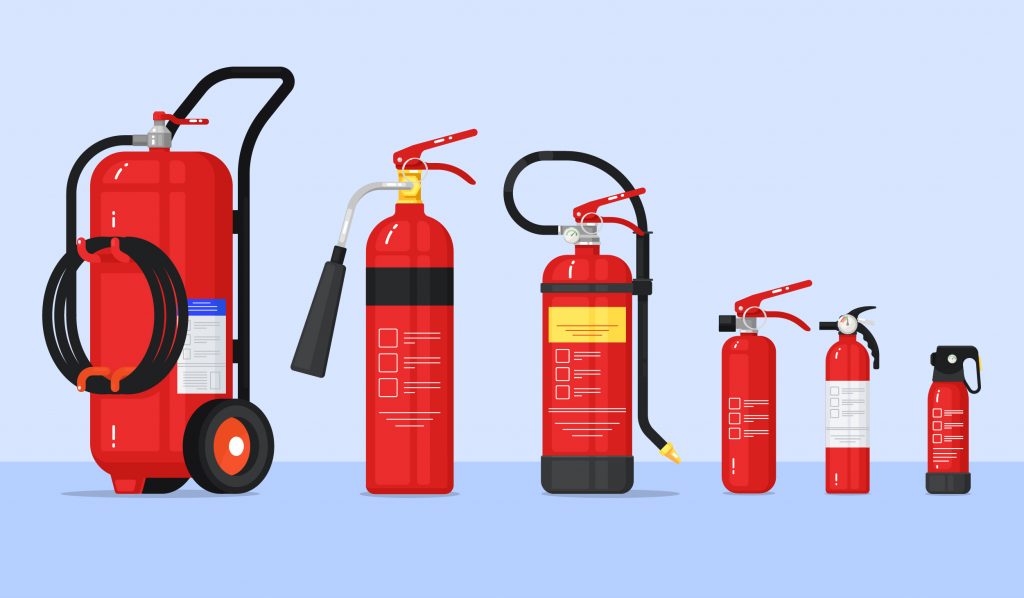What Fire Extinguisher Size Do I Need?
As with so many things to do with fire safety in the workplace, the answer to this question will usually be determined as a result of your annual fire risk assessment. This will not only provide an overview of the fire risks present at your workplace, but it will also detail the best way of tackling a blaze should one occur.
We’ve previously discussed in detail the different types of fire extinguishers that are available to fight the different kinds of fire that might occur in different workplaces.

However, when faced with obtaining fire extinguishers for your own workplace, it’s not just the type of fire extinguisher you need to worry about – you also need to know how many you’ll need and how big each one should be.
After all, both fire extinguishers and the fires themselves can come in a wide variety of sizes. There would be little point in trying to put out a burning building with a small hand-held extinguisher, while using the largest available extinguisher on a small fire in an enclosed space could generate more problems than it fixes.
This is why the fire risk assessment is so important, because it should pull all these factors together to provide you with the perfect combination of fire extinguisher type, size and quantity for your particular premises.
Nevertheless, there are a few factors you might need to consider:
User capability
If you’re expecting your employees to use fire extinguishers to tackle a blaze, you need to be confident that they have the strength and ability to do so effectively. If you’ve filled your workplace with only the largest possible extinguishers, you may find that half of your people are unable to lift and operate them.
Room size and materials
It follows that the bigger the fire you’re likely to be faced with, the bigger the extinguisher you’ll need to deal with it. It also follows that the more combustible the materials on fire the faster the fire is likely to spread and the more suppressant you’ll need to bring it under control.
Ratings on fire extinguishers
Some of the more common extinguishers are rated for the size of fire they are capable of tackling successfully and you’ll find this information on the extinguisher label. For example, water extinguishers might have a rating that says 13A – the minimum required in the average workplace.
The number actually represents the size of a stack of wooden sticks it can extinguish under test conditions – in this case a stack measuring 0.5m x 0.56m x 1.3m. An extinguisher with a 21A rating should be capable of dealing with a stack measuring 0.5m x 0.56m x 2.1m and so on.
Another way of using this information is to measure your extinguisher need based on the size of the floor space it’s intended to cover. In this case, you multiply the square footage of the space by 0.065, with the result being the minimum total rating of the extinguishers needed.
For example: for a 600m2 room, you multiply 600 x 0.065, which gives a figure of 39. To provide adequate coverage, you would need extinguishers with a combined rating of at least 39. Two 21A extinguishers would do that.
In the case of Class B fires it’s a little more straightforward, because the number attached represents the number of litres of burning fuel that the extinguisher can successfully tackle. Extinguishers for Class C, Class D and electrical fires don’t carry a numerical rating, while the rating on Class F extinguishers relates to the number of litres of burning sunflower oil they can extinguish without reignition within ten minutes.
Full details on the ratings applied to UK fire extinguishers can be found in BS EN 3-7.
If you want expert advice on the type, number and size of fire extinguishers that would be most suitable for your workplace, why not talk to the experts at Scutum London? As well as providing professional fire risk assessments, we’re experts in all aspects of fire safety in the workplace, making us the go-to professionals for businesses across South East England, including London and Surrey.
Get in touch with us now to arrange a free site visit, arrange for a fire risk assessment or get a free, cost-effective quotation for your fire extinguisher requirements.
Request a Callback
Just fill in your details below and we'll get back to you as soon as we can!

About Scutum London
Scutum London is a leading expert in fire safety and security solutions for businesses and organisations located across South East England, including London and Surrey.
From fire alarms, fire extinguishers and fire risk assessments to access control, CCTV and intruder alarm systems – and a lot more besides – we offer a comprehensive range of products and services designed to keep you, your business and your staff and visitors safe.
With decades of industry experience to call on, we’re proud to hold accreditations from leading trade associations and bodies such as British Approvals for Fire Equipment (BAFE), the British Fire Consortium, the Fire Industry Association (FIA) and Security Systems and Alarms Inspection Board (SSAIB).
If you’d like to find out more about Scutum London, get in touch with our friendly team or explore our products and services on our site.

